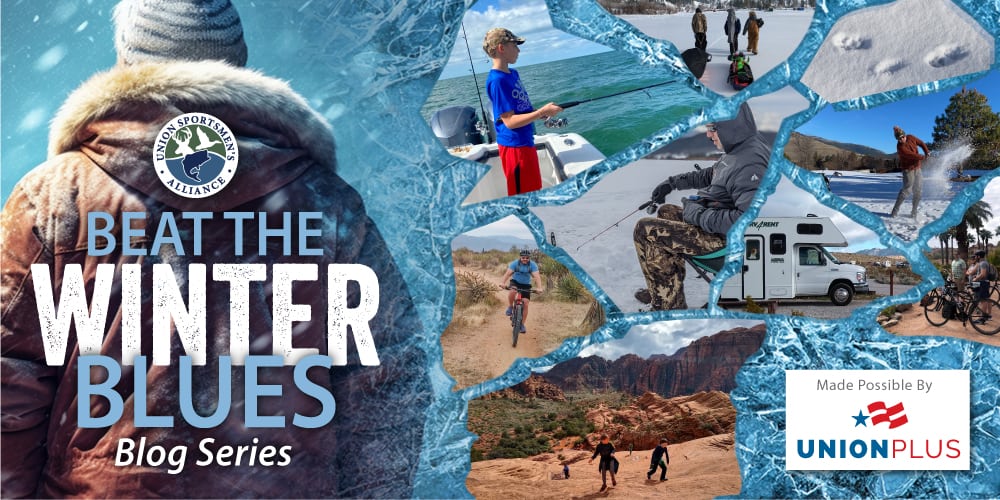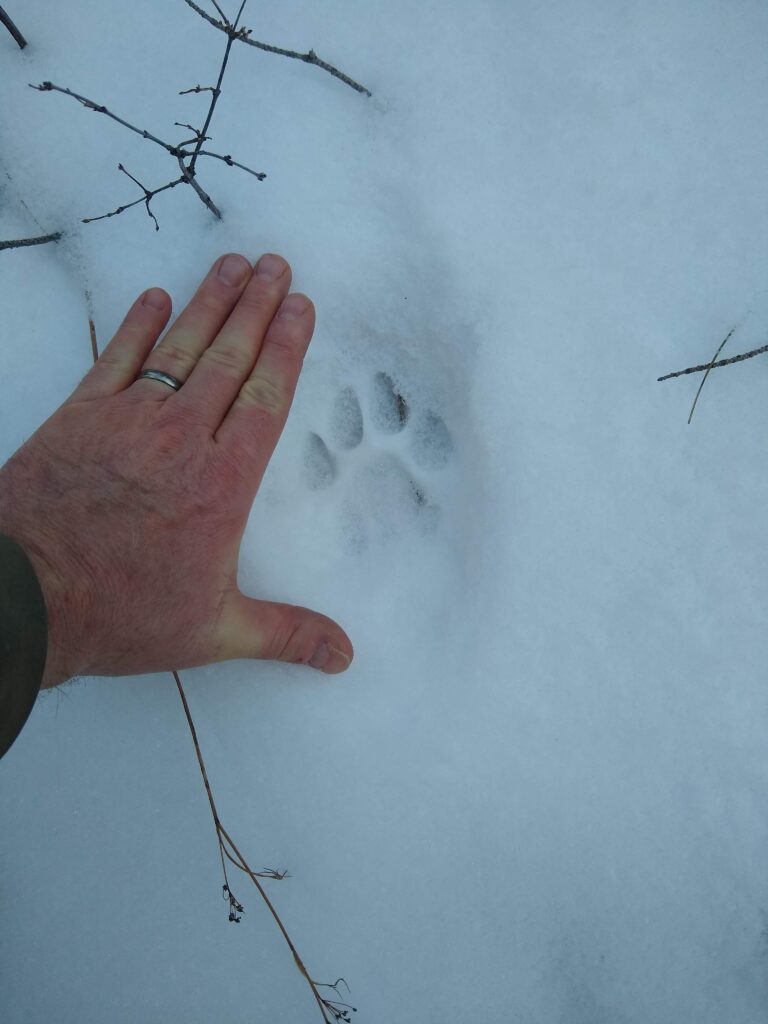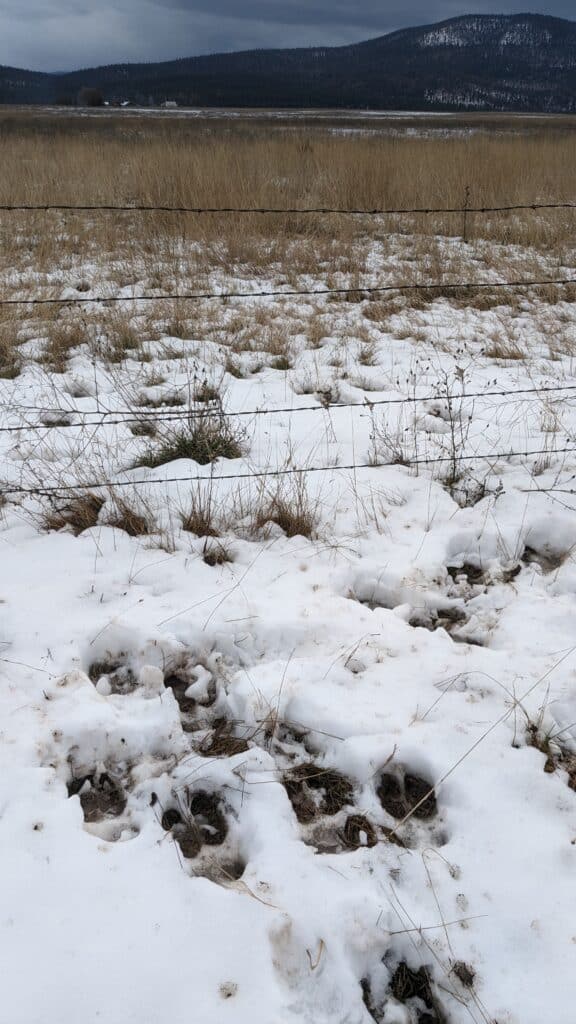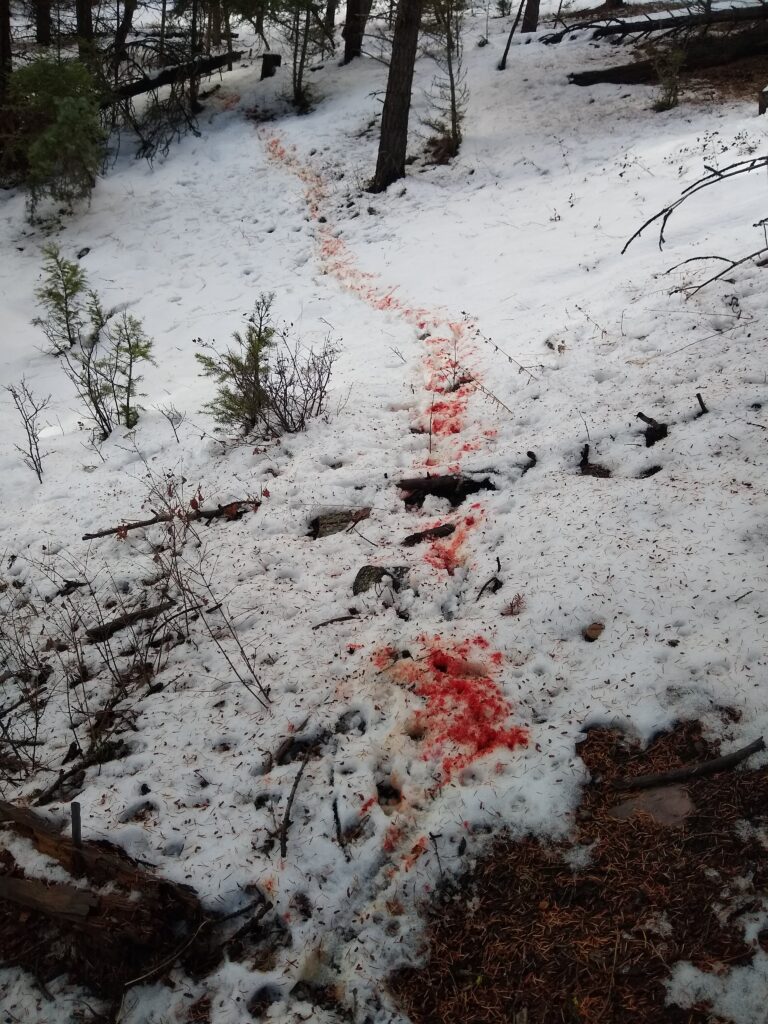
Guide to Snowprints
By PJ DelHomme
Winter may seem like a slow time in the woods, but animal tracks made in snow tell a different story. Spice up your next winter hike by knowing those prints.

Use Your Hands As A Frame of Reference To Determine Species
Guided by the light of a headlamp, I was cross-country skiing one night as it was lightly snowing. Near my turnaround, I spotted fresh tracks in the trail. Something had been walking down the road toward me. When it heard, smelled, or saw me approach, it bailed off the road and into the ravine below. Upon inspection, I realized a decent-sized mountain lion had been out for an evening stroll. The prints were well-defined and had little snow on top of them; I knew they were fresh. I also knew it was a lion and not a dog because it lacked any sign of claws in the print.
Animal tracks in the snow, whether mid-winter or during hunting season, can tell you about what’s traveling in the area and even what those animals are doing. Let’s look at some tracks and common scenes played out in the woods across the country.
Track Patterns
Once you start looking, you’ll notice plenty of action on top of the snow. The most obvious are animal tracks. Naturalists and trackers lump tracks into four categories to help make sense of all those footprints.
- Leapers and hoppers have bigger back legs than front legs. Their front feet land first, then their back feet land in front, leaving clumps of four tracks. Rabbits, hares, mice, and squirrels are leapers and hoppers.
- Bounders have long bodies and legs that are all the same size. They move like an accordion. Just watch your dog chase a tennis ball. That’s a bounder, as are weasels, ferrets, and pine martens.
- Waddlers are slow and steady, with relatively large bodies and short legs. They lift both feet on one side of their body before lifting both feet on the other side. The front foot lands next to the opposite back foot. Bears, porcupines, and raccoons are all waddlers.
- Striders, or zig-zaggers, lift the opposite front foot and back foot at the same time. They usually have long legs and conserve energy by leaving a straight line of single tracks. When walking, cats, canines, deer, elk, coyotes, and humans are all striders.
Deer Stories

These Tracks Look Partially Melted and Iced Over – Probably More Than A Day Old
Rather than simply stroll around the woods, hunters bundle up and head out before sunrise, hoping to fill the freezer. Good hunters become keen observers of the natural world, which includes the art of tracking. They use tracks to identify animal species, sex, size, and even speed of travel.
For example, to determine the age of a track, compare it to your own tracks. If the deer’s track is iced over and your track is powdery soft, it could mean the buck walked by the day before, melted during the day, and then froze that night. If it looks like your boot print, slow down and keep your head on a swivel.
How can you tell if the track belongs to a buck? You have to put the pieces together to be sure. Big bucks tend to be front-heavy, meaning their front hooves will splay out to support that weight. Then again, if deer are running, their hooves will also splay out. A buck’s rear track will likely fall slightly to the inside of the front tracks. In contrast, a doe’s casual rear track should be slightly outside the front tracks.
Instead of following tracks in the direction they’re going, do the opposite. By tracking in reverse, you will likely run into a deer’s bed, indicated by a bowl-shaped depression of melted snow and ice. Check to see if urine is present. If it’s in the middle, it’s a buck. If it’s on the perimeter, it’s likely a doe.
Action Stories
Kids love to play in the snow. Who doesn’t love a good snow angel? Animals play in the snow, too, and they die there, too. Hunters love a fresh skiff of snow, especially for tracking wounded animals. I’m red-green colorblind, and without snow, blood tracking is incredibly difficult for me. Snow makes short work of deer recovery.
Humans aren’t the only hunters in the woods. Sometimes, you come across patches of fur and maybe a little blood. Take a minute to circle around the scene of the crime. Find out what species was dining and what species was on the menu. If the kill site is fresh, retrace the events leading up to the moment of attack. If it was a bobcat taking out a turkey, try to find out where it was before becoming a sandwich. Find the bobcat tracks and see if you can find where it crouched before it pounced. How far did it stalk the turkey? Where did it pick up the trail? All these events are written in the snow if you can read the language.

There Is A Story Here That Can Be Told Through Tracks
While hunting in Montana, I like to walk up closed logging roads. I’m not the only one. These relatively flat and wide trails are animal superhighways, especially for predators. Reading their tracks tells me if grizzlies are still around in late November or hibernating. When I cut their tracks, I think twice about hunting the spruce thickets alone. Driving around open roads tells plenty of stories, too. Where I hunt, the elk migrate to winter range every year. When a big storm approaches, I can almost guarantee they will cross the road in the same spot each year after a big storm. I would have never known that if it weren’t for their tracks in the snow.
Even though most humans retreat to the indoors, where it’s cozy and inviting during the winter, wild animals still make a living outdoors. That is never more apparent than when you get outside and read those stories they left behind. The more often you get out there and the harder you look, the more you’ll find.
PJ DelHomme writes and edits content from his home in western Montana. He runs Crazy Canyon Media and Crazy Canyon Journal.
Related Articles in this Series:
Do You Really Want to Go Skiing? – Union Sportsmen’s Alliance







